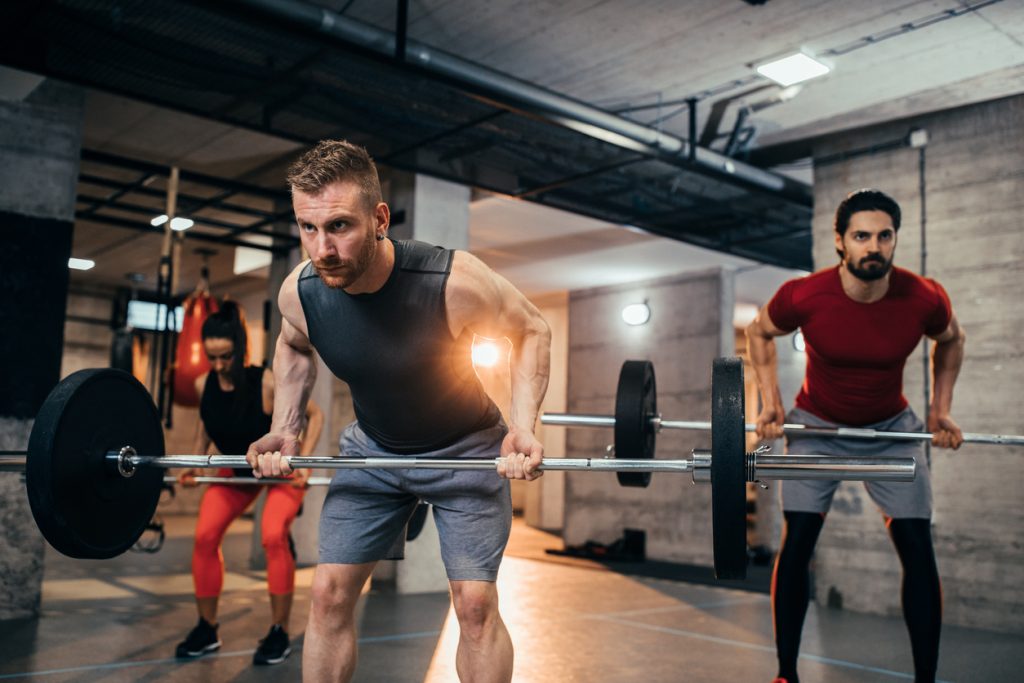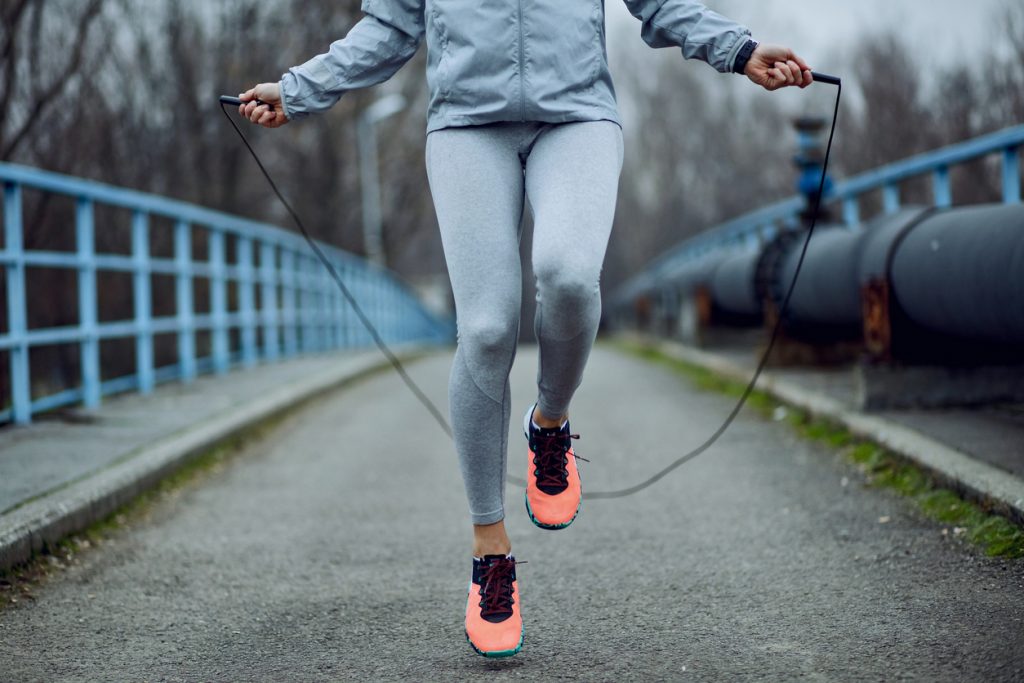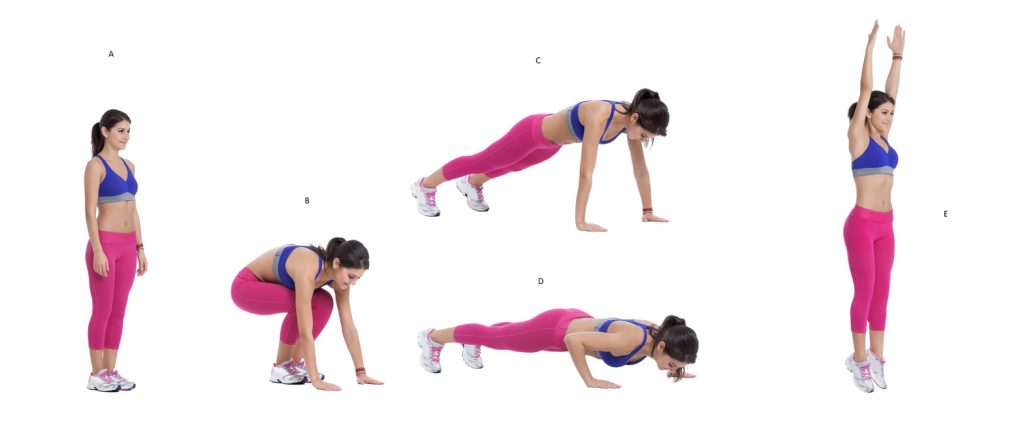Upper Body with Load
Bench press
Lying on your back on a bench, raise the loaded barbell above your pectoral muscles. Let the opposing strength of your pecs help you. For the plyometric version, do not stop at the end of the descent. Instead, use the momentum to move on to the next movement.
This exercise will significantly strengthen your pecs, shoulders and biceps. It will also improve your throwing power, momentum and percussion.
The plyometric version of the bench press is perfect for many sports. This includes ball sports and combat sports.
Rowing
Stand with your torso slightly bent forward while keeping your back straight. Extend your arms, lift a loaded Olympic barbell (or dumbbells) and bring the bar towards your abdomen. Remember, always use the push-up when the bar is at its lowest.
This is an exercise that puts a lot of strain on the back muscles as well as the shoulders and arms, especially the biceps, when held in a supinated position.
This allows you to optimise your throwing and gripping power.
The rowing will also help you develop your back muscles while protecting your spine.
Bench press
This is a classic strength training workout that is performed by pulling a barbell on a pulley in a seated position, with your chest tilted back and straight. The movement is performed dynamically and without stopping.
It is a movement that will especially help you develop your back muscles.
It is a very beneficial exercise, as it requires less strength than the pull-up and gives excellent stability than the barbell rowing.
The prone pull-up is well suited for beginners. It is also beneficial for high-level athletes, provided that proper loads are used.
Medicine ball throw
The aim here is to throw at a small target which is high up. This is to improve both dexterity and explosiveness on the throws.
The medicine ball weighs several kilos. This is why this exercise is perfect for boosting the strength and stamina of the shoulders and arms. It is a movement that is especially dedicated to ball sports. But boxers can also benefit from the transmission of energy to the upper body through leg support.
If you want to focus on explosive strength, do quick throws at a wall, standing close to it. This position allows you to do a sequence of throws. Practiced in long sets, the effectiveness of this exercise on endurance is considerable.
Lower body with load
Squat
This is the same exercise as in the unloaded exercises but with an additional load.
Calves
In order not to neglect this part of the body, train using a press machine (the same one used for the thighs), on your toes to emphasize the calves. To be energetic with this type of training, opt for light loads. Although the calf muscles are small and often overlooked, they play an important role in explosive jumping and speed. It is therefore essential to work them.
A little focus on the Burpees
It is an exercise which does not fit into the categories mentioned above.
The Burpees remains by far the best plyometric exercise. It strengthens all parts of the body. To perform it :
- Start from a standing position,
- bend your legs to perform a squat,
- On landing the squat, put both hands on the floor and throw your feet far back to get into a plank position,
- Follow with a push-up,
- In a short, quick movement, return your feet to the starting position.
- With your legs bent in a squat position, jump as high as possible.
This is a complete workout that works most of the muscle groups in the body, making it a popular and effective exercise for all sports.
Our pro tips
Plyometrics is very physically demanding. It is also a rather complex workout. Plyometrics is strongly advised against for beginners, who can injure themselves because of the speed of the movements.
Advice: first master the static and dynamic movements before starting plyometrics.
As plyometrics is very demanding on the body, frequent training is not recommended. Two workouts per week is more than enough, in which case the fatigue and negative effects will outweigh the benefits.
It is also essential and recommended that plyometric exercises are performed in short sets. Remember that each exercise requires considerable physical strength. On long sets, exhaustion will quickly be felt, which will obviously affect your movements. Indeed, you must remember one essential thing: in plyometrics, quality comes before quantity.
For beginners, prefer bodyweight training. It is less abrupt and will give you time to adapt to the exercises and the rhythm set.
When a competition is approaching, stop doing plyometrics at least two weeks beforehand. This will give your body a chance to regain its strength and be more efficient and available on the day.
Another point: warming up is very important before performing plyometric exercises. As the movements are short and powerful, sprains or other more serious injuries can occur at any time, especially if the muscles are not properly warmed up.
As plyometrics relies on the elasticity of the muscles, stretching is essential to optimise this elasticity. But be careful not to stretch before or after a workout, as this can worsen small muscle tears caused by training. Also remember that stretching is not a prolonged process.
To conclude
The ideal plyometric programme has not yet been developed. It is up to you to choose the exercises and training sets that are suitable for your physical condition and sporting activities. In practice, you can even change and invent exercises as you progress.
It is also recommended to carry out a fullbody programme to develop and work all parts of the body. The overall progress will be more satisfying. So choose exercises that give you the opportunity to work your pecs, back and legs. The best exercises in this category are jumping push-ups, jumping pull-ups and jumping squats. Don't forget the cardiovascular system either, which you can optimise by opting for exercises such as split running.



